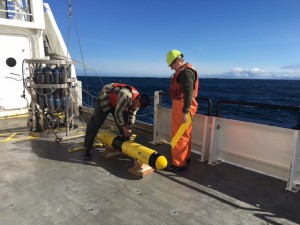We arrived at the dock at Newport Wednesday evening, unloaded our gear from the ship — including all the samples collected on the cruise — and brought it back to OSU. Angel White and her team are packing up most of their instruments and supplies, and shipping them to Hawaii, where they have another research cruise next week. Miguel Goni will be headed out on the Oceanus again on Monday for a cruise with undergraduate students.
It has been great experiencing a research cruise first-hand, and getting to know the scientists and crew. Along with learning about the research that is being done, it has also been interesting to experience the rhythm of the cruise: The captain comes over the ship’s loudspeaker announcing the next sampling station, a group goes outside to deploy the CTD, water samples are taken when the CTD is returned to the deck, and the samples are filtered and analyzed in the lab while other instruments are deployed off the back of the boat. Then, the ship moves to the next station where the process starts all over again, all while aboard a moving, sometimes heavily

rocking, boat. In the little downtime there is, there are people to talk to, movies to watch, books to read, and, on this cruise, a small Easter egg hunt. While everyone on board works very hard – some operating on very little sleep—you can tell that they all really enjoy what they do.
I’ve also learned that things don’t always go as planned: Instruments don’t work, weather is unpredictable, and seasickness is real. There were very few mishaps on this cruise, but I heard stories about CTD lines breaking, sending the instrument to the seafloor, or getting the VMP stuck on a crab pot, never to be seen again. When you are on a ship, you can’t order something new or go to the lab to pick up those filters you forgot.

On this cruise, the weather and malfunctioning instruments caused us to change course several times in order to maximize our time at sea. But the delays, changes and obstacles are all part of studying the ocean. While there are satellites and other instruments that scientists can use to monitor the sea remotely, there is no substitute for going out on the ocean. To fully understand and see what is happening during the winter off the coast of Oregon, scientists need observations like the ones collected this week. I am just grateful that I got to go along for the ride.
Nanci Bompey is AGU’s public information manager. She is spending a week aboard the R/V Oceanus with scientists from Oregon State University (OSU) who are studying the role that small rivers play in the productivity of the coastal ocean during the winter. Click here to read Nanci’s previous blogs from this trip.





